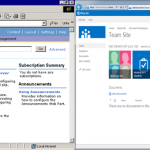Older versions of SharePoint

Continuing to make the most out of the older versions of SharePoint
Hopefully one of the above logo’s (or more?!) is familiar too you and that you have one of these platforms deployed inside your organisation.
Though it’s easy to get caught up in the media marketing and sales pitch that surrounds SharePoint 2013, the latest update released by Microsoft provides an evolutionary not revolutionary update to this popular platform.
It’s true older versions of SharePoint can simply be upgraded to the latest offerings from Microsoft, be that into cloud (Microsoft’s Office 365 and traditional hosting vendors) or continue with on-premise deployments. And of course there are solution integrators like ourselves as well as other partners and third party tools to help with this activity.
But more often than not there needs to be a compelling business case to do so, especially those who have just moved to SharePoint 2010. Sometimes the new features can drive this, other times factors such a introducing a new capability or service for the business can drive a upgrade or introduction of the latest version of SharePoint. But upgrades aren’t always an option open to all.
Indeed we have several customers who have only recently moved to SharePoint 2010 last year. Some are some are still on SharePoint 2007 (and older versions!). Hence moving to SharePoint 2013 just isn’t on the agenda for these and will not be any time soon, for many different reasons. Nor for that matter is moving to the cloud an option, sometimes for technical or budgetary reasons but more often than not its political or cultural challenges.
For these situations, there is a huge need to derive further value with the investment already made in SharePoint. Making it do more, to introduce new capabilities to do things smarter, more efficiently or just to simply exploit existing features you perhaps never knew where there or have simply hadn’t the business need to enable (even though you are licensed for them perhaps).
The maturity model for SharePoint deployments that we experience as system integrators is very familiar in that typically an intranet has been rolled out, and in some cases maybe an extranet. The next step is what we’ve been mentioning in our past posts here and here which is to further utilise and explore the platform as a framework for other business applications. These examples offer a great way to leverage the platform for further benefit without necessarily being on the latest version.
So the key message is that you don’t necessarily have to be on the ‘latest and greatest’ to derive further benefit from your existing investment in SharePoint. But you should absolutely be using some of the latest thinking, best practices and methods for managing change on it, that has evolved during the time that SharePoint has gone through it’s iterations. This knowledge, together with experience in all of the SharePoint versions, including the cloud offerings is key for us as a partner, to be able to advise and guide customers down the most appropriate route to take.
By
Andrew Walmsley





Comments are closed.